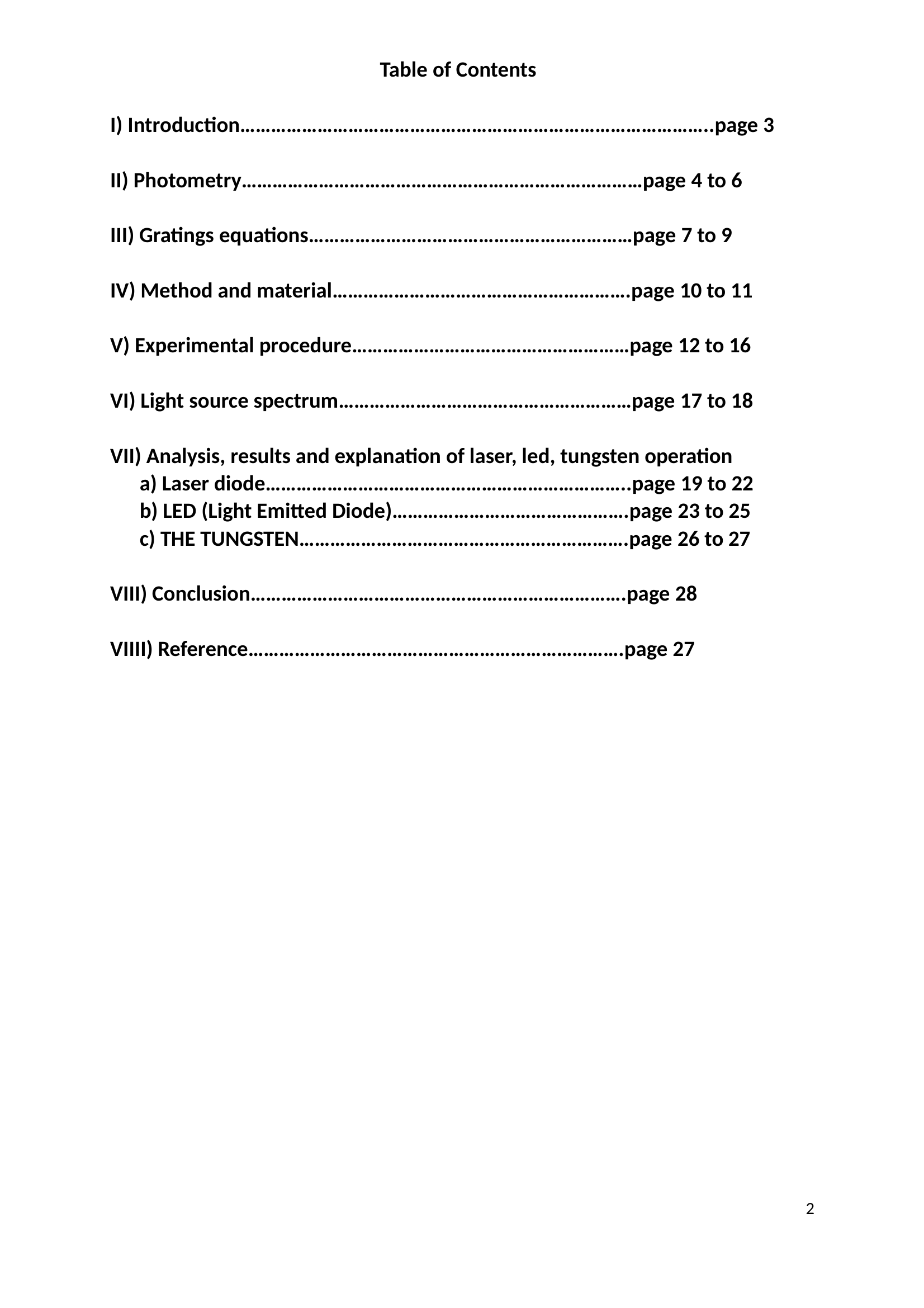Assignment 2: The lab report Written by Hichem Bekioui sTUDENT NUMBER: 15055647 Opto-Electronics for Communications Assignment 2: Supervised by Dr Kang li Table of ContentsI) Introduction………………………………………………………………………………..page 3II) Photometry……………………………………………………………………page 4 to 6III) Gratings equations………………………………………………………page 7 to 9 IV) Method and material………………………………………………….page 10 to 11 V) Experimental procedure………………………………………………page 12 to 16VI) Light source spectrum…………………………………………………page 17 to 18VII) Analysis, results and explanation of laser, led, tungsten operationa) Laser diode……………………………………………………………..page 19 to 22b) LED (Light Emitted Diode)……………………………………….page 23 to 25c) THE TUNGSTEN……………………………………………………….page 26 to 27VIII) Conclusion……………………………………………………………….page 28VIIII) Reference……………………………………………………………….page 27 I) Introduction On this assignment we used a spectrophotometer to measure the amount of different light source as Tungsten, LEDs, Laser Diode Tungsten. The purpose of this experiment was to view the light intensity according to wavelength (obtained by calculation) for each light source.What is the Spectrophotometry?A spectrophotometer is employed to measure the amount of light that a sample absorbs. The instrument operates by passing a beam of light through a sample and measuring the intensity of light reaching a detector. The beam of light consists of a stream of photons. When a photon encounters an analyte molecule, there is a chance the analyte will absorb the photon. This absorption reduces the number of photons in the beam of light, thereby reducing the intensity of the light beam.The Spectrophotometer allows you to view and measure the spectral pattern (spectrum) produced by a light source. The Collimating Slits and Collimating Lens produce a narrow beam of parallel light rays. The Grating disperses the beam of light into a spectrum with different colours at different angles but with all of the light of a given color in a parallel beam. The Focusing Lens focuses these parallel beams of color into spectral lines (see Fig. 2). The narrow slit on the Aperture Disk (part of the Aperture Bracket) allows light of a single color to enter the High Sensitivity Light Sensor. The High Sensitivity Light Sensor (included with the Spectrophotometer System) measures the intensity of the light while the Rotary Motion Sensor (included with the Spectrophotometer System) measures the angle to which the light is diffracted by the Grating II) PhotometryWhat is a photometry? Photometry is the science of the measurement of light, in terms of its perceived brightness to the human eye. It is distinct from radiometry, which is the science of measurement of radiant energy (including light) in terms of absolute power. In modern photometry, the radiant power at each wavelength is weighted by a luminosity function that models human brightness sensitivity. Typically, this weighting function is the photopic sensitivity function, although the scotopic function or other functions may also be applied in the same way.The human eye is not equally sensitive to all wavelengths of visible light. Photometry attempts to account for this by weighing the measured power at each wavelength with a factor that represents how sensitive the eye is at that wavelength. When we look a lit object (we look at a small zone of the object), the eye perceives two things:- The more or less clear aspect so the values- The colored aspect so colours From the physical point of view, a light is characterized by:· Its spectral composition· The energy which it transportsSo, two lights having the same spectral composition and the same energy are physically identical. This task is complicated immensely by the eye’s nonlinear response to light. It varies not only with wavelength but also with the amount of radiant flux, whether the light is constant or flickering, the spatial complexity of the scene being perceived, the adaptation of the iris and retina, the psychological and physiological state of the observer, and a host of other variables.The sensitivity of the human eye to light varies with wavelength. A light source with a radiance of one watt/m2 -radian of green light, for example, appears much brighter than the same source with a radiance of one watt/m2 -radian of red or blue light. In photometry, we do not measure watts of radiant energy. Rather, we attempt to measure the subjective impression produced by stimulating the human eye-brain visual system with radiant energy. Luminous IntensityToday the international standard is a theoretical point source that has a luminous intensity of one candela (the Latin word for “candle. Together with the CIE photometric curve, the candela provides the weighting factor needed to convert between radiometric and photometric measurementsWax candles were used as national light source standards in the 18th and 19th centuries. England, for example, used spermaceti (a wax derived from sperm whale oil). Consider, for example, a monochromatic point source with a wavelength of 510 nm and a radiant intensity of 1/683 watts per steradian. The photonic luminous e...


































